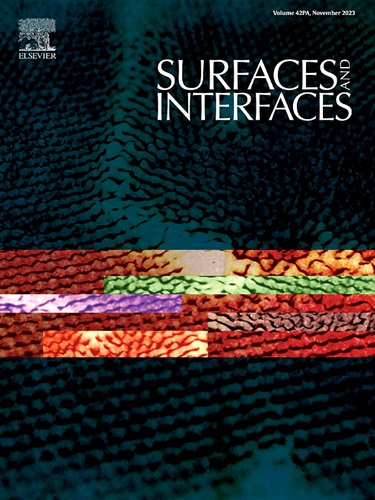Environmental benign approach for copper oxide nanoparticles synthesis for efficient wastewater treatment and biomedical applications
IF 5.7
2区 材料科学
Q2 CHEMISTRY, PHYSICAL
引用次数: 0
Abstract
This study introduces an eco-friendly, economical, and facile method of CuO NPs (copper oxide nanoparticles) green synthesis utilizing Terminalia chebula seed powder extract. Characterization of CuO NPs confirmed their successful synthesis, revealing size dimensions of 5 - 12.2 nm and spherical shape. Energy Dispersive Spectroscopy (EDX) analysis showed the predominant presence of copper and oxygen elements, constituting 77.9 % and 22.0 % by weight, respectively. CuO NPs exhibited significant efficacy in removing Crystal Violet (CV) dye through adsorption, achieving 93.8 % removal of 50 ppm CV dye by NPs dosage of 2 g/L within 40 min of contact time. CuO NPs adsorbed CV dye using Langmuir isotherm model. Synthesized NPs demonstrated excellent reusability for five consecutive cycles of dye removal. Moreover, a notable 72.2 % dye decolorization was observed when textile wastewater spiked with 75 ppm of CV dye was treated with these NPs. Another important feature of synthesized CuO NPs was that they also showed excellent remediation capabilities for heavy metals namely, Chromium and Lead. According to the phytotoxicity assessment on Vigna radiata seedlings, textile wastewater treated with CuO NPs is suitable for irrigation, which is consistent with the goals of sustainability. In addition, CuO NPs have promising antibacterial activity against both Gram +ve and Gram -ve bacteria. Therefore, the conducted work presents an environmentally benign approach for CuO NPs synthesis, offering versatile applications in biomedical field and wastewater treatment.
求助全文
约1分钟内获得全文
求助全文
来源期刊

Surfaces and Interfaces
Chemistry-General Chemistry
CiteScore
8.50
自引率
6.50%
发文量
753
审稿时长
35 days
期刊介绍:
The aim of the journal is to provide a respectful outlet for ''sound science'' papers in all research areas on surfaces and interfaces. We define sound science papers as papers that describe new and well-executed research, but that do not necessarily provide brand new insights or are merely a description of research results.
Surfaces and Interfaces publishes research papers in all fields of surface science which may not always find the right home on first submission to our Elsevier sister journals (Applied Surface, Surface and Coatings Technology, Thin Solid Films)
 求助内容:
求助内容: 应助结果提醒方式:
应助结果提醒方式:


